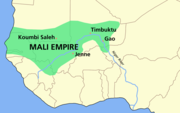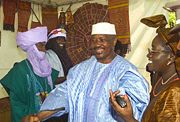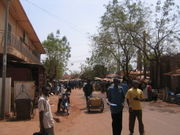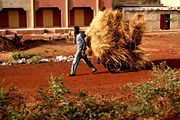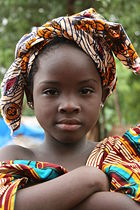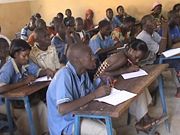Mali
2008/9 Schools Wikipedia Selection. Related subjects: Africa; African Countries
| République du Mali Republic of Mali
|
||||||
|---|---|---|---|---|---|---|
|
||||||
| Motto: "Un peuple, un but, une foi" "One people, one goal, one faith" |
||||||
| Anthem: Pour l'Afrique et pour toi, Mali "For Africa and for you, Mali" |
||||||
|
|
||||||
| Capital (and largest city) |
Bamako |
|||||
| Official languages | French | |||||
| Demonym | Malian | |||||
| Government | semi-presidential republic | |||||
| - | President | Amadou Toumani Touré | ||||
| - | Prime Minister | Modibo Sidibé | ||||
| Independence | from France | |||||
| - | Declared | September 22, 1960 | ||||
| Area | ||||||
| - | Total | 1,240,192 km² ( 24th) 478,839 sq mi |
||||
| - | Water (%) | 1.6 | ||||
| Population | ||||||
| - | July 2007 estimate | 11,995,402 ( 73rd) | ||||
| - | Density | 11/km² ( 207th) 28/sq mi |
||||
| GDP ( PPP) | 2005 estimate | |||||
| - | Total | $14.400 billion ( 125th) | ||||
| - | Per capita | $1,154 ( 166th) | ||||
| Gini (1994) | 50.5 (high) | |||||
| HDI (2007) | ▲ 0.380 (low) | |||||
| Currency | CFA franc ( XOF) |
|||||
| Time zone | GMT ( UTC+0) | |||||
| Internet TLD | .ml | |||||
| Calling code | +223 | |||||
Mali, officially the Republic of Mali (French: République du Mali), is a landlocked nation in Western Africa. Mali is the seventh largest country in Africa, bordering Algeria on the north, Niger on the east, Burkina Faso and the Côte d'Ivoire on the south, Guinea on the south-west, and Senegal and Mauritania on the west.
Consisting of eight regions, Mali's borders on the north reach deep into the middle of the Sahara, while the country's southern region, where the majority of inhabitants live, features the Niger and Senegal rivers. The country's economic structure centers around agriculture and fishing. Some of Mali's natural resources include gold, uranium, and salt. Due to a high incidence of poverty, Mali is considered to be one of the poorest nations in the world.
Present-day Mali was once part of three West African empires that controlled trans-Saharan trade: the Ghana Empire, the Mali Empire (from which Mali is named), and the Songhai Empire. In the late 1800s, Mali fell under French control, becoming part of French Sudan. Mali gained independence in 1959 with Senegal, as the Mali Federation in 1959. A year later, the Mali Federation became the independent nation of Mali in 1960. After a long period of one-party rule, a 1991 coup led to the writing of a new constitution and the establishment of Mali as a democratic, multi-party state.
History
Mali was once part of three famed West African empires which controlled trans-Saharan trade in gold, salt, and other precious commodities. These Sahelian kingdoms had neither rigid geopolitical boundaries nor rigid ethnic identities. The earliest of these empires was the Ghana Empire, which was dominated by the Soninke, a Mande-speaking people. The nation expanded throughout West Africa from the 8th century until 1078, when it was conquered by the Almoravids.
The Mali Empire later formed on the upper Niger River, and reached the height of power in the fourteenth century. Under the Mali Empire, the ancient cities of Djenné and Timbuktu were centers of both trade and Islamic learning. The empire later declined as a result of internal intrigue, ultimately being supplanted by the Songhai Empire in the 15th century. The Songhai people originated in current northwestern Nigeria. The Songhai Empire long been a major power in West Africa and remained subject to the Mali Empire's rule. In the late 14th century, the Songhai gradually gained independence from the Mali Empire and expanded, ultimately subsuming the entire eastern portion of the Mali Empire. The empire's eventual collapse was largely the result of a Berber invasion in 1591. The fall of the Songhai Empire marked the end of the region's role as a trading crossroads. Following the establishment of sea routes by the European powers, the trans-Saharan trade routes lost significance.
In the colonial era, Mali fell under the control of the French beginning in the late 1800s. By 1905, most of the area was under firm French control as a part of French Sudan. In early 1959, Mali (then the Sudanese Republic) and Senegal united to become the Mali Federation. The Mali Federation gained independence from France on June 20, 1960. Senegal withdrew from the federation in August 1960, which allowed the Sudanese Republic to form the independent nation of Mali on September 22, 1960. Modibo Keïta was elected the first president. Keïta quickly established a one-party state, adopted an independent African and socialist orientation with close ties to the East, and implemented extensive nationalization of economic resources.
In November 1968, following progressive economic decline, the Keïta regime was overthrown in a bloodless military coup led by Moussa Traoré. The subsequent military-led regime, with Traoré as president, attempted to reform the economy. However, his efforts were frustrated by political turmoil and a devastating drought between 1968 to 1974. The Traoré regime faced student unrest beginning in the late 1970s and three coup attempts. However, the Traoré regime repressed all dissenters until the late 1980s. The government continued to attempt economic reforms, and the populace became increasingly dissatisfied. In response to growing demands for multi-party democracy, the Traoré regime allowed some limited political liberalization, but refused to usher in a full-fledged democratic system. In 1990, cohesive opposition movements began to emerge, and was complicated by the turbulent rise of ethnic violence in the north following the return of many Tuaregs to Mali.
Anti-government protests in 1991 led to a coup, a transitional government, and a new constitution. In 1992, Alpha Oumar Konaré won Mali's first democratic, multi-party presidential election. Upon his reelection in 1997, President Konaré pushed through political and economic reforms and fought corruption. In 2002, he was succeeded in democratic elections by Amadou Toumani Touré, a retired general, who had been the leader of the military aspect of the 1991 democratic uprising. Today, Mali is one of the most politically and socially stable countries in Africa.
Geography
Mali is a landlocked nation in West Africa, located southwest of Algeria. At 1,240,000 square kilometres (479,000 sq mi), Mali is the world's 24th-largest country and is comparable in size to South Africa or Peru. Most of the country lies in the southern Sahara, which produces a hot, dust-laden harmattan haze common during dry seasons. The country extends southwest through the subtropical Sahel to the Sudanian savanna zone. Mali is mostly flat, rising to rolling northern plains covered by sand. The Adrar des Ifoghas lies in the northeast.
The country's climate ranges from subtropical in the south to arid in the north. Most of the country receives negligible rainfall; droughts are frequent. Late June to early December is the rainy season. During this time, flooding of the Niger River is common. The nation has considerable natural resources, with gold, uranium, phosphates, kaolinite, salt and limestone being most widely exploited. Mali faces numerous environmental challenges, including desertification, deforestation, soil erosion, and inadequate supplies of potable water.
Regions and cercles
Mali is divided into eight regions (régions) and one district. Each region has a governor. Since Mali's regions are huge, the country is subdivided into 49 cercles, totaling 288 arrondissements. Mayors and elected members of the city councils officiate the arrondissements.
The regions and district are:
- Gao
- Kayes
- Kidal
- Koulikoro
- Mopti
- Ségou
- Sikasso
- Tombouctou (Timbuktu)
- Bamako (capital district)
Politics and government
Mali is a constitutional democracy governed by the constitution of January 12, 1992, which was amended in 1999. The constitution provides for a separation of powers among the executive, legislative, and judicial branches of government. The system of government can be described as "semi-presidential."
Executive power is vested in a president, who is elected to a five-year term by universal suffrage and is limited to two terms. The president serves as chief of state and commander in chief of the armed forces. A prime minister appointed by the president serves as head of government and in turn appoints the Council of Ministers. The unicameral National Assembly is Mali’s sole legislative body, consisting of deputies elected to five-year terms. Following the 2007 elections, the Alliance for Democracy and Progress held 113 of 160 seats in the assembly. The assembly holds two regular sessions each year, during which it debates and votes on legislation that has been submitted by a member or by the government.
Mali’s constitution provides for an independent judiciary, but the executive continues to exercise influence over the judiciary by virtue of power to appoint judges and oversee both judicial functions and law enforcement. Mali's highest courts are the Supreme Court, which has both judicial and administrative powers, and a separate Constitutional Court that provides judicial review of legislative acts and serves as an election arbiter. Various lower courts exist, though village chiefs and elders resolve most local disputes in rural areas.
Foreign relations and military
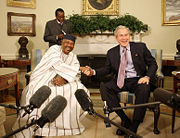
Mali's foreign policy orientation has become increasingly pragmatic and pro-Western over time. Since the institution of a democratic form of government in 2002, Mali’s relations with the West in general and with the United States in particular have improved significantly. Mali has a longstanding yet ambivalent relationship with France, a former colonial ruler. Mali is active in regional organizations such as the African Union. Working to control and resolve regional conflicts, such as in Côte d’Ivoire, Liberia, and Sierra Leone, is one of Mali’s major foreign policy goals. Mali feels threatened by the potential for the spillover of conflicts in neighboring states, and relations with those neighbors are often uneasy. General insecurity along borders in the north, including cross-border banditry and terrorism, remain troubling issues in regional relations.
Mali’s military forces consist of an army, which includes land forces and a small navy and air force, as well as the paramilitary Gendarmerie and Republican Guard, all of which are under the control of Mali's Ministry of Defense and Veterans, headed by a civilian. The military is underpaid, poorly equipped, and in need of rationalization. Organization has suffered from the incorporation of Tuareg irregular forces into the regular military following a 1992 agreement between the government and Tuareg rebel forces. The military has generally kept a low profile since the democratic transition of 1992. The incumbent president, Amadou Toumani Touré, is a former army general and as such reportedly enjoys widespread military support. In the annual human rights report for 2003, the U.S. Department of State rated civilian control of security forces as generally effective but noted a few "instances in which elements of the security forces acted independently of government authority."
Economy
Mali is one of the poorest countries in the world. The average worker's annual salary is approximately US$1,500. Between 1992 to 1995, Mali implemented an economic adjustment program that resulted in economic growth and a reduction in financial imbalances. The program increased social and economic conditions, and led to Mali joining the World Trade Organization on May 31, 1995. The gross domestic product (GDP) has risen as a result. In 2002, the GDP amounted to US$3.4 billion, and increased to US$5.8 billion in 2005, which amounts to approximately 17.6% annual growth rate.
Mali's key industry is agriculture. Cotton is the country's largest crop export and is exported west throughout Senegal and the Ivory Coast. During 2002, 620,000 tons of cotton were produced in Mali but declining cotton prices in 2003 reduced demand for the crop. In addition to cotton, Mali produces rice, millet, corn, vegetables, tobacco, and tree crops. Gold, livestock and agriculture amount to eighty percent of Mali's exports. Eighty percent of Malian workers are employed in agriculture while fifteen percent work in the service sector. However, seasonal variations lead to regular temporary unemployment of agricultural workers.
In 1991, with the assistance of the International Development Association, Mali relaxed the enforcement of mining codes which led to renewed foreign interest and investment in the mining industry. Gold is mined in the southern region and Mali has the third highest gold production in Africa (after South Africa and Ghana). The emergence of gold as Mali’s leading export product since 1999 has helped mitigate some of the negative impact of the cotton and Côte d’Ivoire crises. Other natural resources include kaolin, salt, phosphate, and limestone.
Electricity and water are maintained by the Energie du Mali, or EDM, and textiles are generated by Industry Textile du Mali, or ITEMA. Mali has made efficient use hydroelectricity, consisting of over half of Mali's electrical power. In 2002, 700 kWh of hydroelectric power were produced in Mali.
The Malian government participates in foreign involvement, concerning commerce and privatization. Mali underwent economic reform, beginning in 1988 by signing agreements with the World Bank and the International Monetary Fund. During 1988 to 1996, Mali's government largely reformed public enterprises. Since the agreement, sixteen enterprises were privatized, twelve partially privatized, and twenty liquidated. In 2005, the Malian government conceded a railroad company to the Savage Corporation, which is based in Salt Lake City, Utah, USA. Two major companies, Societé de Telecommunications du Mali (SOTELMA) and the Cotton Ginning Company (CMDT), are expected to be privatized in 2008.
Demographics
In July 2007, Mali's population was an estimated 12 million, with an annual growth rate of 2.7%. The population is predominantly rural (68% in 2002), and 5–10% of Malians are nomadic. More than 90% of the population lives in the southern part of the country, especially in Bamako, which has over 1 million residents.
In 2007, about 48% of Malians were less than fifteen years old, 49% were 15–64 years old, and 3% were 65 and older. The median age was 15.9 years. The birth rate in 2007 was 49.6 births per 1,000, and the total fertility rate was 7.4 children per woman. The death rate in 2007 was 16.5 deaths per 1,000. Life expectancy at birth was 49.5 years total (47.6 for males and 51.5 for females). Mali has one of the world's highest rates of infant mortality, with 106 deaths per 1,000 live births in 2007.
Mali’s population encompasses a number of sub-Saharan ethnic groups, most of which have historical, cultural, linguistic, and religious commonalities. The Bambara are by far the largest single ethnic group, making up 36.5% of the population. Collectively, the Bambara, Soninké, and Malinké, all part of the broader Mandé group, constitute 50% of Mali's population. Other significant groups are the Peul (17%), Voltaic (12%), Songhai (6%), and Tuareg and Moor (10%). Mali historically has enjoyed reasonably good inter-ethnic relations; however, some hereditary servitude relationships exist, as do ethnic tensions between the Songhai and the Tuareg.
Mali’s official language is French, but numerous (40 or more) African languages also are widely used by the various ethnic groups. About 80% of Mali’s population can communicate in Bambara, which is the country’s principal lingua franca and marketplace language. An estimated 90% of Malians are Muslim (mostly Sunni), 9% adhere to indigenous or traditional animist beliefs, and 1% are Christian (about two-thirds Roman Catholic and one-third Protestant). Atheism and agnosticism are believed to be rare among Malians, most of whom practice their religion on a daily basis. Islam as practiced in Mali is moderate, tolerant, and adapted to local conditions; relations between Muslims and practitioners of minority religious faiths are generally amicable. The constitution establishes a secular state and provides for freedom of religion, and the government largely respects this right.
Health and education
Mali faces numerous health challenges related to poverty, malnutrition, and inadequate hygiene and sanitation. Mali's health and development indicators rank among the worst in the world. In 2000, only 62–65 percent of the population was estimated to have access to safe drinking water and only 69 percent to sanitation services of some kind. In 2001, the general government expenditures on health totaled about US$4 per capita at an average exchange rate. Medical facilities in Mali are very limited, and medicines are in short supply. Malaria and other arthropod-borne diseases are prevalent in Mali, as are a number of infectious diseases such as cholera and tuberculosis. Mali’s population also suffers from a high rate of child malnutrition and a low rate of immunization. An estimated 1.9 percent of the adult population was afflicted with HIV/AIDS that year, among the lowest rates in Sub-Saharan Africa.
Public education in Mali is in principle provided free of charge and is compulsory for nine years between the ages of seven and 16. The system encompasses six years of primary education beginning at age seven, followed by six years of secondary education. However, Mali’s actual primary school enrollment rate is low, in large part because families are unable to cover the cost of uniforms, books, supplies, and other fees required to attend. In the 2000–01 school year, the primary school enrollment rate was 61% (71% of males and 51% of females); in the late 1990s, the secondary school enrollment rate was 15% percent (20% of males and 10% of females). The education system is plagued by a lack of schools in rural areas, as well as shortages of teachers and materials. Estimates of literacy rates in Mali range from 27–30% to 46.4%, with literacy rates significantly lower among women than men.
Citations
- ^ a b c Mali country profile, p. 1.
- ^ a b c d e f g h i j k l m n Mali country profile, p. 2.
- ^ a b c d e f g Mali country profile, p. 3.
- ^ Mali country profile, p. 4.
- ^ USAID Africa: Mali. USAID. Last accessed: May 15, 2008. Retrieved on: June 3, 2008.
- ^ a b c d e f Mali country profile, p. 5.
- ^ Martin, Phillip L. (2006). Managing Migration: The Promise of Cooperation. Lanham, Maryland: Lexington Books, 134. ISBN 978-0739113417.
- ^ a b DiPiazza, F., Mali in Pictures, p. 37.
- ^ Imperato, Gavin (2006). " From Here to Timbuctoo: A story of discovery in West Africa". Haverford. Retrieved on 2008- 06-03.
- ^ a b c d e f Mali country profile, p. 14.
- ^ Constitution of Mali, Art. 30.
- ^ Constitution of Mali, Art. 29 & 46.
- ^ Constitution of Mali, Art. 38.
- ^ a b c d e f Mali country profile, p. 15.
- ^ Constitution of Mali, Art. 59 & 61.
- ^ (French) Koné, Denis. Mali: "Résultats définitifs des Législatives". Les Echos (Bamako) ( August 13, 2007). Retrieved on June 24, 2008.
- ^ Constitution of Mali, Art. 65.
- ^ Constitution of Mali, Art. 81.
- ^ Constitution of Mali, Art. 83-94.
- ^ a b c d e f g Mali country profile, p. 17.
- ^ a b c d e Mali country profile, p. 18.
- ^ a b c d e f g h i j k CIA world factbook. CIA. Retrieved on June 3, 2008.
- ^ a b c d e f g h i " Mali". U.S. State Department (May 2008). Retrieved on 2008- 06-04.
- ^ " Mali". U.S. State Department (2008-05). Retrieved on 2008- 06-04.
- ^ Mali country profile, p. 9.
- ^ a b Hale, Briony (1998- 05-13). " Mali's Golden Hope", BBC News, BBC. Retrieved on 2008- 06-04.
- ^ a b c d Cavendish, Marshall (2007). World and Its Peoples: Middle East, Western Asia, and Northern Africa. Tarrytown, New York: Marshall Cavendish, 1367. ISBN 978-0761475712.
- ^ May, Jacques Meyer (1968). The Ecology of Malnutrition in the French Speaking Countries of West Africa and Madagascar. New York, New York: Macmillan Publishing Company, 291. ISBN 978-0028489605.
- ^ Campbell, Bonnie (2004). Regulating Mining in Africa: For Whose Benefit?. Uppsala, Sweeden: Nordic African Institute, 43. ISBN 978-0761475712.
- ^ Hale, Briony (2002- 04-26). " Mali's Golden Hope", BBC News, BBC. Retrieved on 2008- 06-04.
- ^ African Development Bank (2001). African Economic Outlook. OECD Publishing, 186. ISBN 9264197044.
- ^ a b c d e f g h Mali country report, p. 6.
- ^ a b c d e f g h i j k l m Mali country profile, p. 7.
- ^ a b c d e Mali country profile, p. 8.
- ^ Michelle Crabill and Bruce Tiso. Mali Resource Website. Fairfax County Public Schools. January 2003. Retrieved on June 4, 2008.
- ^ Velton, R., Mali, p. 29.
- ^ a b c d Milet & Manaud, Mali, p. 128.
- ^ a b c d Velton, R., Mali, p. 28.
- ^ a b Pye-Smith & Drisdelle, Mali: A Prospect of Peace?, p. 13.
- ^ a b c Velton, R., Mali, p. 30.
- ^ a b c Milet & Manaud, Mali, p. 146.
- ^ a b c Milet & Manaud, Mali, p. 151.
- ^ a b c d e f DiPiazza, F., Mali in Pictures, p. 55.
- ^ a b c Hudgens, Trillo, and Calonnec, The Rough Guide to West Africa, p. 320.
- ^ "Malian Men Basketball". Africabasket.com. Retrieved June 3, 2008.
- ^ Chitunda, Julio. "Ruiz looks to strengthen Mali roster ahead of Beijing". FIBA.com ( March 13, 2008). Accessed on June 24, 2008.



